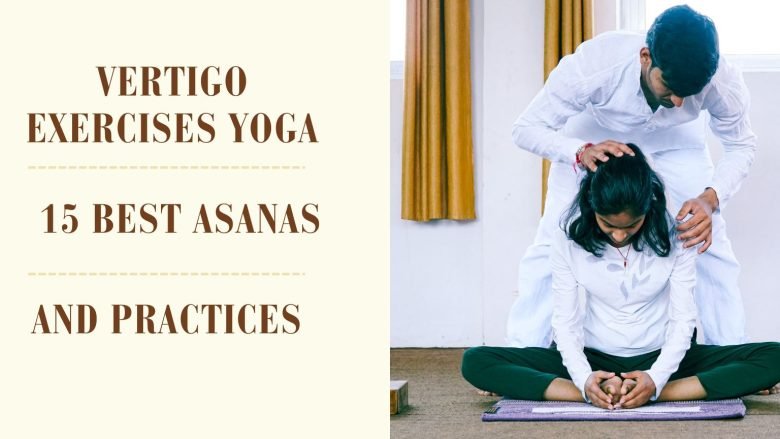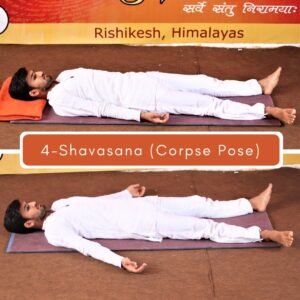Vertigo exercises yoga is a feeling of dizziness or like the spinning world. Yoga can alleviate balance, decrease dizziness, and toughen up the body. Letting the full cinema gentle yoga releases anxiety, loosens and stimulates blood flow to the brain.
Doing this daily may decrease the number of vertigo attacks, ease the vertigo-induced fear of walking or standing. Here are the top 10 yoga pose remedies for Vertigo safely in a natural way.
What are the Best Yoga Poses for Vertigo?
If you have vertigo, the following yoga poses will help you deal with your fear;
1. Vrikshasana
Vrikshasana will make your legs strong and will enable concentration. Stand on the legs, put one foot on the thigh of the opposite leg and raise the body with balance as you stare steadily. The pose conditions your brain and body to maintain balance, which is beneficial to patients of vertigo. Learn slowly and with wall assistance. With time, you will have improved balance and decreased unsteadiness.
2. Tadasana
It is also a basic standing yoga pose which may improve body balance and posture. Sit or stand up straight with your feet touching and your arms hanging loose at the sides, concentrating on deep breathing.
To prevent dizziness gaze your eyes upon one point. The pose will help you gain strong legs and core muscles, which in turn will help control the force of vertigo. Spend 1-2 minutes a day with training, to be more stable and not experience dizziness.
3. Shavasana
Shavasana is also a deep relaxation posture; it calms down your nervous system. Place the body on its back and have the arms and legs at rest. Keep your eyes closed, breathe, relax your mind and body. The pose relieves stress; this is the most common trigger of vertigo. Doing the Shavasana for several minutes each day may leave you feeling refreshed, calm, and more able to manage your dizziness.
4. Balasana
Balasana will also do some gentle back stretching and calm your mind. Get on your knees on the ground, bow, and put your forehead on the mat with one arm forward. This position will enhance blood flow to the head and lower the symptoms of vertigo. It also reduces anxiety and enhances attention. Train every day to become more established and steady in movement.
5. Viparita Karani
This posture improves the circulation of blood inside the brain and does away with the sensation of dizziness. Lie on your back, and your legs will be positioned against the wall at right angles. When you are relaxed, your arms should be by your sides with frequent breathing.
Viparita Karani eliminates the wearing out and enhances stability. Even 5-10 minutes of exercise a day can alleviate vertigo and make you feel more energised. You can consider it the best yoga for dizziness and vertigo.
6. Setu Bandhasana
Setu Bandhasana adds to the strength of your neck, shoulder, and back muscles. Lie on your back, bend the knees, and go up with the hips – but you must keep the shoulders resting on the floor. This pose enhances blood circulation to the head and aids in keeping vertigo under control.
Do it slowly, and do not make any abrupt head movements. Daily practice builds you stronger and more stable in your body, less likely to be dizzy.
7. Paschimottanasana
This asana soothes down your agitated mind, and it elongates your spinal muscles. Sit with extended legs, and bend forward over your leg and reach for your toes on the ground. Relax your head, breathe slowly. The position can improve flexibility and train the nervous system; now it may also help treat this vertigo. This yoga helps to improve blood circulation to the brain and brings a sense of balance.
8. Matsyasana
By stretching the chest and increasing the lungs’ capacity, this yoga posture stimulates more oxygen to the brain. A backbend, but with your head leaned backwards (not flat), turning your chest up. This pose strengthens the flexibility of the neck. For those with vertigo, they could help the patients regain their composure and even their balance. Make sure to stretch when you practice it comfortably on your neck.
9. Ardha Matsyendrasana
This is a nice cross or twist that is great to keep the spine flexible and to get the blood flowing to your head. Turn your self while in the bent leg position, and rest the other leg from the bent leg. Ardha Matsyendrasana can strengthen your core, which guides you in balance. No rushing twists. Proceed slowly to avoid getting dizzy. It can also reduce his or her bodyweight allowing a more stable position.
10. Supta Baddha Konasana
The Asana Supta Baddha Konasana causes the body and mind to be relaxed, hence useful in case of vertigo. You lie on your back, sound your foot to the other and allow the knees to drop outward. To perform this yoga, put your hands on your stomach and breathe.
By relieving stress, this yoga pose helps to improve blood circulation. Every day exercises may have a positive effect in reducing the triggers of vertigo and relax a person in general.
What are the Benefits of Vertigo Exercises Yoga?
The benefits of vertigo exercise include;
1. Improves Balance and Stability
Vertigo yoga poses will educate both your body and mind to stand still when you are dizzy. Your leg and core muscles also significantly improve when you exercise more, thereby making everyday activities less dangerous as there is no possibility of falling and becoming unsteady.
2. Boosts Blood Circulation to the Brain
A lot of vertigo yoga practices enhance blood circulation to the neurons and the inner ear. This is applicable in supporting the nervous system, reducing spinning sensations and aiding brain functionality so that one feels more alert and levelled in their daily life.
3. Reduces Stress and Anxiety
Vertigo is usually brought about by stress. Appropriate yoga postures induce calmness to the nervous system, slow down the breath and release mental tension. This has a good impact on the mind that cannot get dizzy and emotional discomfort, which is caused by anxiety.
4. Strengthens Core and Leg Muscles
When the muscles are strong, this improves balance. Training using many yoga poses will tone your legs, hips, and core, making them stable. This additional support means that one can walk, stand and move without being wobbly and feeling insecure.
5. Promotes Relaxation and Better Sleep
The problem of yoga for vertigo may disrupt the sleeping pattern. Harmonizing yoga postures promotes profound relaxation and reduces the level of stress hormones, resulting in better sleep. A lazy body heals quicker, and it can deal with vertigo symptoms throughout the day.
Conclusion
Vertigo symptoms can be easily and slowly controlled through yoga. These asanas improve overall balance, increase the availability of oxygen and relax nerves. Dizziness will be considerably minimized through regular exercise routine and good health lifestyle skills, leading to better health and wellbeing. Relax and learn to listen to your body and be regular so you can achieve the best results.
Read Also:-




